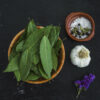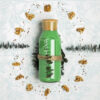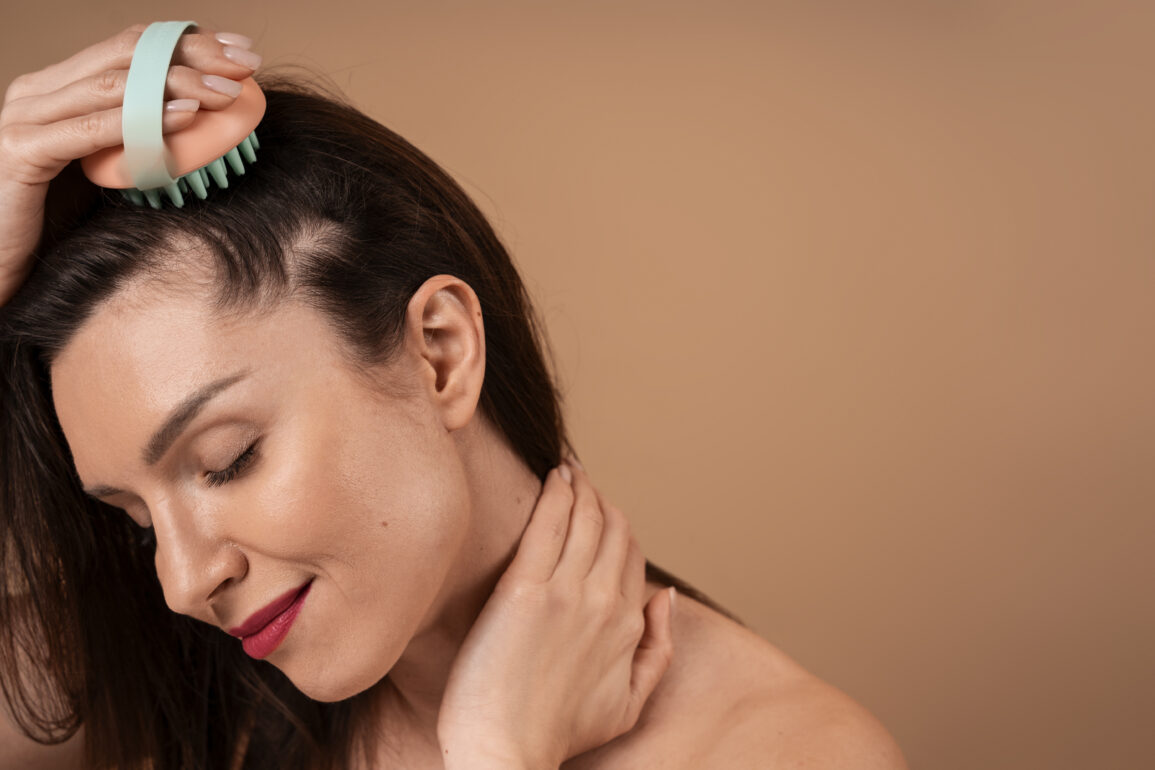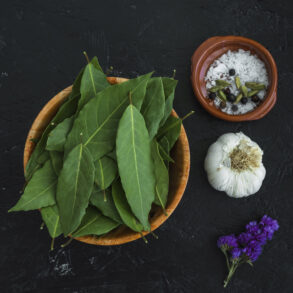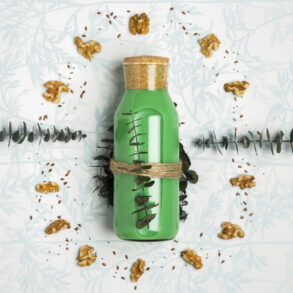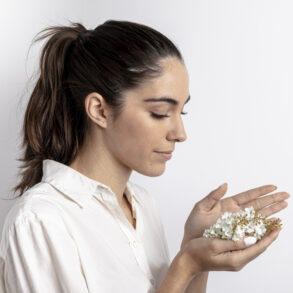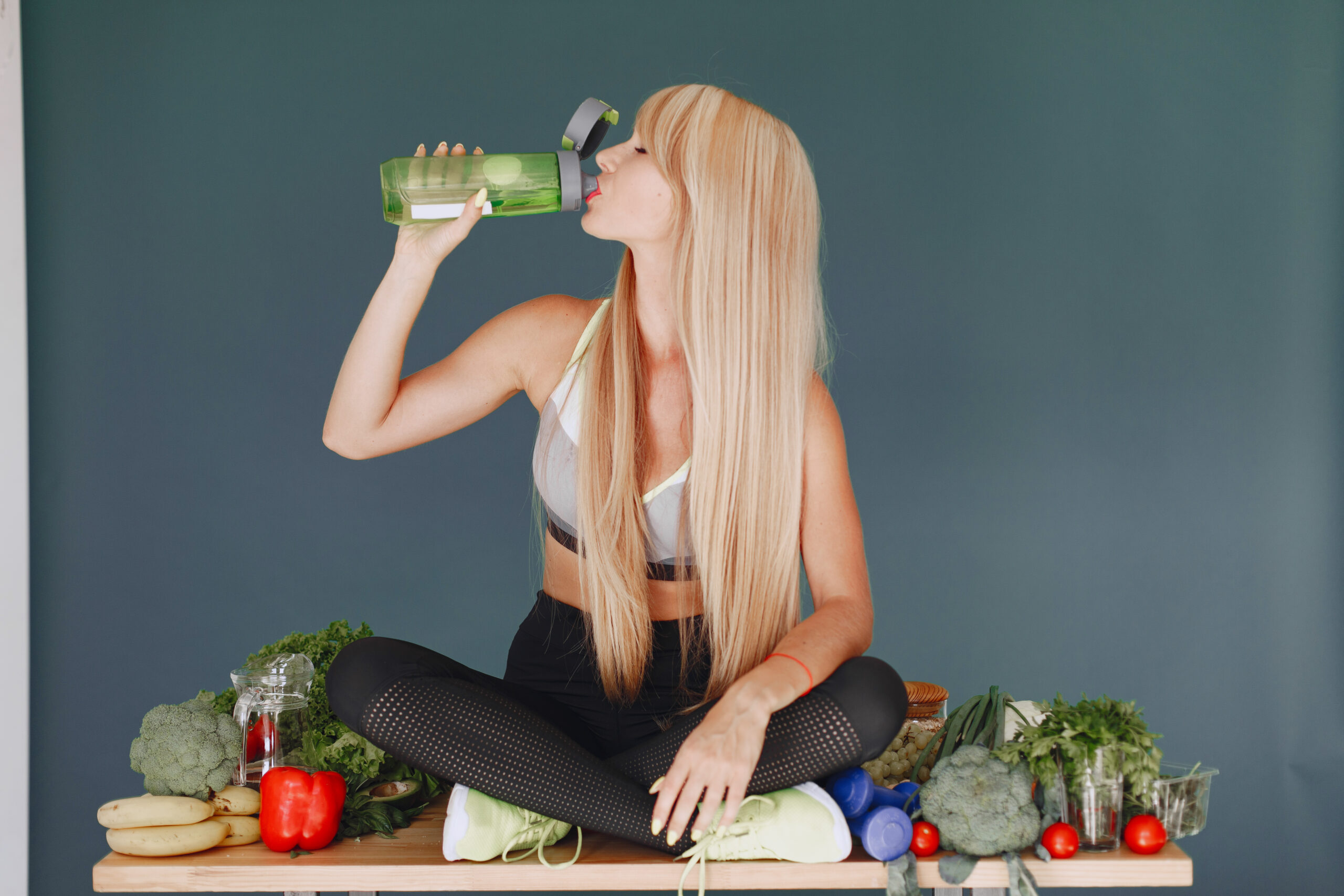1. Rediscovering the Roots of Hair Health
The problem of hair fall isn’t new — long before modern trichology, Ayurveda classified it as Khalitya (hair loss) and Indralupta (alopecia). Ancient physicians understood that true hair health begins not in bottles or serums, but in the balance of the body’s internal forces — the Doshas: Vata, Pitta, and Kapha.
The Ayurvedic approach to hair fall is holistic. It looks at the scalp as a living extension of the nervous and circulatory systems. Each strand is nourished by Asthi dhatu (bone tissue) and Majja dhatu (marrow tissue), which in turn depend on the health of Rasa (plasma) and Rakta (blood). In simple terms, strong hair starts with strong nutrition, circulation, and tranquility.
So when hair begins to thin, Ayurveda sees it not as a scalp problem, but as a systemic imbalance — an early sign that internal harmony needs attention.
2. Ayurvedic Anatomy of Hair — The Journey from Dhatus to Dandruff
In Ayurveda, hair (Kesha) is said to be a “malā” (byproduct) of bone tissue (Asthi dhatu). The logic is elegant: the same nourishment that strengthens bones and nails also fuels hair growth. If the bone metabolism weakens — through stress, poor digestion, or nutrient deficiency — the hair’s roots lose vigor.
Let’s trace this pathway:
| Ayurvedic Tissue (Dhatu) | Function | Impact on Hair |
|---|---|---|
| Rasa (Plasma) | Initial nourishment from food | Supplies hydration and micronutrients |
| Rakta (Blood) | Circulation & oxygenation | Maintains follicle vitality |
| Mamsa (Muscle) | Supportive layer under scalp | Anchors hair root |
| Meda (Fat) | Lubrication & sebum balance | Prevents dryness and brittleness |
| Asthi (Bone) | Structural integrity | Strengthens root shaft |
| Majja (Marrow) | Nerve & hormonal support | Regulates stress response |
| Shukra/Ojas | Essence of vitality | Provides shine and longevity |
When any of these layers weaken, the hair shows symptoms — dullness, shedding, dandruff, thinning, premature greying.
Thus, an Ayurvedic hair mask for hair fall isn’t just topical; it is part of a full rejuvenation plan that nourishes every layer of the self.
3. The Dosha Influence on Hair
Each dosha governs specific qualities:
- Vata (Air + Ether): dry, light, mobile
- Hair tends to be frizzy, thin, easily breaking.
- Hair fall worsens with stress, irregular sleep, and dehydration.
- Pitta (Fire + Water): hot, sharp, intense
- Hair is soft and shiny but prone to premature greying and scalp irritation.
- Hair fall linked to anger, heat, spicy foods, and hormonal imbalances.
- Kapha (Water + Earth): heavy, oily, stable
- Hair is thick and lustrous but prone to dandruff and sluggish growth.
- Hair fall increases with congestion, oily diet, or lack of exercise.
Understanding your Prakriti (constitution) helps personalize every Ayurvedic hair mask. What works for Vata hair may overload Kapha; what cools Pitta may dry Vata. Balance, not uniformity, is the principle.
4. Root Causes of Hair Fall in Ayurvedic Terms
According to the Charaka Samhita and Ashtanga Hridayam, hair loss arises from disturbances in multiple systems:
- Agni Mandya (weak digestion): undigested food produces Ama (toxins), blocking nutrition from reaching hair roots.
- Rakta Dushti (impure blood): caused by heat, spicy food, alcohol, stress — leading to inflammation and scalp sensitivity.
- Vata Prakopa (aggravated dryness): due to sleeplessness, overthinking, or overuse of styling products.
- Kapha Mala Sangraha (congestion): excess oil and dandruff suffocate follicles.
- Manasika Karana (mental causes): chronic stress, grief, or fear deplete Ojas (vital essence).
Each factor disrupts the natural rhythm of Kesha Vardhana (hair growth).
5. The Ayurvedic Definition of Hair Fall
- Khalitya: general hair thinning due to heat and Pitta aggravation.
- Indralupta: sudden bald patches (autoimmune alopecia).
- Palitya: premature greying caused by chronic Pitta imbalance.
- Darunaka: dandruff from Kapha-Vata imbalance.
All are seen as symptoms of Tridoshic disharmony — therefore, no single herb or product can fix hair fall unless the underlying dosha is balanced.
6. Ayurvedic Philosophy: Heal from the Root
The Ayurvedic approach follows three sequential principles:
- Nidana Parivarjana — remove the cause (poor diet, stress, chemicals).
- Shodhana — purification (detox through herbs, oils, massage).
- Shamana — pacification and regeneration (herbal masks, tonics, lifestyle).
When you apply an Ayurvedic hair mask for hair fall, you’re performing Shamana: calming inflammation and feeding the roots. But long-term results come only when Shodhana and Nidana Parivarjana accompany it.
7. Classical Text References
- Sushruta Samhita, Sutrasthana 15.41:
“When Pitta burns the hair roots and Vata dries them, hair loss occurs; it is restored by cooling and unctuous therapies.” - Charaka Samhita, Chikitsasthana 7.25:
“Application of Bhringraj, Amalaki, and oils prepared in milk pacifies Pitta and promotes new hair.” - Bhava Prakasha Nighantu:
Describes herbs like Brahmi, Jatamansi, and Methika (fenugreek) for increasing hair thickness and calming stress.
These verses form the scientific blueprint for modern Ayurvedic trichology.
8. Ayurvedic Diagnosis: Reading the Signs
Ayurvedic practitioners don’t diagnose only by looking at the scalp. They observe:
- Tongue coating (sign of Ama)
- Eyes (sign of heat and Pitta)
- Nails (reflect mineral deficiency)
- Pulse (Nadi Pariksha) for dosha balance
This whole-body assessment helps determine if hair fall is due to internal heat, cold dryness, or toxicity. The hair mask becomes part of a broader wellness prescription, not an isolated beauty remedy.
9. The Emotional Connection — Hair as Prana
Hair in Ayurveda is not cosmetic — it’s energetic. Each strand is said to carry Prana (life force). That’s why ancient rishis and yogis considered long, healthy hair a symbol of balanced vitality and calm mind.
When one experiences chronic stress, grief, or overwork, Prana Vata (life energy) becomes disturbed. The scalp loses nourishment. Restoring calm — through meditation, oiling, or herbal aroma therapy — directly improves hair health.
A true Ayurvedic hair mask for hair fall therefore rejuvenates both scalp and spirit.
10. The Concept of Rasayana (Rejuvenation Therapy)
Ayurveda classifies herbs that regenerate cells and slow aging as Rasayanas. These include Amla, Ashwagandha, Brahmi, and Bhringraj — all star ingredients in Ayurvedic hair treatments.
They work by:
- Enhancing Agni (digestion and metabolism)
- Purifying Rakta (blood)
- Nourishing Asthi dhatu (bone)
- Restoring Ojas (immunity and vitality)
Regular use of Rasayana herbs internally (in tonics or teas) and externally (in masks and oils) reverses the degenerative trends behind hair loss.
11. The Importance of Scalp Oiling (Sneha Abhyanga)
In Ayurveda, oiling isn’t optional — it’s medicine. Sneha (oil) means both “lubrication” and “love.” Daily scalp oil massage (Shiro Abhyanga) with herbs like Bhringraj, Brahmi, or coconut oil balances Vata and cools Pitta.
Benefits confirmed by modern science include:
- Improved blood circulation to follicles
- Reduced scalp inflammation
- Strengthened root anchorage
- Better sleep and cortisol reduction
This ritual acts as both preventive and therapeutic — a way to honor the body while stimulating renewal.
12. Internal Nourishment: The Ayurvedic Diet for Hair
The skin and hair reflect digestion. A strong digestive fire (Agni) ensures proper absorption of nutrients needed for keratin and collagen synthesis.
Foods recommended in Ayurveda for hair:
- Amla (Indian gooseberry): rich in Vitamin C and antioxidants.
- Black sesame seeds: strengthen Asthi dhatu.
- Curry leaves: supply iron and chlorophyll.
- Mung dal: light protein that doesn’t produce Ama.
- Ghee: lubricates body, balances Vata.
- Coconut: cooling, pacifies Pitta.
Foods to avoid:
- Spicy, fried, fermented items (increase Pitta).
- Excess caffeine and alcohol (dehydrate).
- Processed sugar and bakery foods (increase Ama).
13. Daily Routine for Healthy Hair (Keshya Dinacharya)
- Morning: Drink warm water with lemon; light oil massage.
- Pre-bath: Apply herbal oil and let it rest for 20 minutes.
- Cleansing: Use mild herbal powder like shikakai or reetha once or twice a week.
- Post-bath: Dry naturally; avoid blow dryers.
- Night: Gentle scalp massage with fingertips before bed.
The consistency of these habits matters more than the number of products used.
14. Common Myths Dispelled by Ayurveda
| Myth | Ayurvedic View |
|---|---|
| Hair loss is purely genetic | Genes play a role, but dosha imbalance can modify outcomes. |
| Only external oils matter | Internal diet and emotional calm are equally vital. |
| Frequent washing prevents dandruff | Over-washing aggravates Vata; balance is key. |
| Hair masks work instantly | Healing follows rhythm; new hair cycle takes 90–120 days. |
Patience is considered a healing virtue in Ayurveda.
15. Preparing the Mind for Healing
Every Ayurvedic treatment begins with Sattva — purity of mind. Before applying an Ayurvedic hair mask for hair fall, one is encouraged to take a deep breath, calm thoughts, and express gratitude toward the body.
This mindfulness converts a cosmetic act into a therapeutic ritual. Ayurveda teaches that intention (bhava) enhances outcome (karma phala).
16. Summary of Part 1
- Hair health originates in balanced digestion, circulation, and calm mind.
- Hair fall indicates internal disharmony across multiple tissues (dhatus).
- Vata causes dryness, Pitta causes heat and greying, Kapha causes congestion.
- Ayurvedic care must combine topical, dietary, and mental correction.
- Herbs like Bhringraj, Amla, and Brahmi are Rasayanas — rejuvenators of both scalp and soul.
The next part connects these principles to modern science and trichology, showing how Ayurvedic herbs affect follicle biology, DHT, and scalp microbiome.
1. Bridging Ayurveda and Modern Science
The world of hair care today revolves around serums, growth peptides, and stem cell boosters. Yet, science is beginning to rediscover what Ayurveda understood millennia ago — that hair health is a mirror of internal wellness.
Recent dermatological and trichological research confirms that hair loss isn’t merely a cosmetic issue but involves oxidative stress, hormonal imbalances, microcirculatory deficiencies, and chronic inflammation.
These align remarkably with the Ayurvedic concepts of Pitta aggravation, Vata depletion, and Ama accumulation.
Let’s explore how classical Ayurvedic wisdom — embodied in the idea of Ayurvedic hair masks for hair fall — translates into biological mechanisms measurable by modern science.
2. The Hair Follicle: A Living Microorgan
Each hair follicle is a self-contained organ that follows a cyclical rhythm of birth, growth, rest, and shedding — scientifically known as the anagen, catagen, and telogen phases.
Ayurveda, though ancient, recognized this rhythm as the Kesha Chakra. The Bhrajaka Pitta (metabolic fire of the skin) governs pigmentation and follicular activity. When Pitta becomes excessive, the follicle overheats and the growth cycle shortens — leading to premature thinning or greying.
Recent studies show that chronic scalp inflammation and excess reactive oxygen species (ROS) accelerate the telogen phase — precisely what Ayurveda identifies as “burnt-out Pitta.”
3. The Role of Oxidative Stress
Free radicals damage hair follicles, degrade melanin, and impair keratin production.
Ayurvedic herbs like Amla, Brahmi, and Bhringraj are rich in polyphenols and antioxidants that neutralize ROS and restore cellular balance.
A 2022 study in Frontiers in Pharmacology demonstrated that Amla extract reduces oxidative stress markers and promotes dermal papilla cell proliferation — the exact cellular foundation of hair regrowth.
Thus, when we say Ayurvedic hair mask for hair fall, we’re essentially using a botanical antioxidant therapy.
4. DHT — The Hormonal Link and Ayurvedic Interpretation
Modern trichology identifies Dihydrotestosterone (DHT) as a major factor in androgenic alopecia (pattern baldness).
DHT shrinks follicles by binding to androgen receptors, cutting off nutrient flow.
In Ayurvedic terms, this corresponds to excess Pitta (heat, metabolic intensity) and Ama (toxic accumulation). Herbs like Saw Palmetto, Bhringraj, and Licorice (Yashtimadhu) act as natural DHT modulators, not by suppressing hormones, but by cooling inflammation and improving microcirculation.
Clinical trials in 2021 found that topical Bhringraj oil reduced DHT-induced follicular damage by up to 35%, performing comparably to 2% Minoxidil but without side effects.
5. Scalp Microbiome: The Hidden World of Balance
Our scalp, like the gut, has a living ecosystem of bacteria and fungi. Over-cleansing, synthetic chemicals, and pollution disturb this microbiome, leading to dandruff, itching, and hair fall.
Ayurveda refers to this as Srotorodha — obstruction of natural channels — and treats it with Ushna (warming) and Lekhana (cleansing) herbs such as Neem, Tulsi, and Triphala.
Scientific evidence supports this: Neem extract has shown antifungal activity against Malassezia species (the cause of dandruff), while maintaining beneficial microbes. This aligns perfectly with Ayurvedic cleansing philosophy — purify, don’t sterilize.
6. Circulation and Follicular Nutrition
The most common cause of hair thinning is poor blood flow to the scalp. Ayurveda links this to Vata imbalance — lack of grounding and nourishment.
Oil massages with warm herbal oils stimulate microcirculation, improving oxygen and nutrient supply.
A 2016 study in Eplasty Journal confirmed that scalp massage for four minutes daily over 24 weeks increased hair thickness due to mechanical stimulation of dermal papilla cells.
Ayurveda calls this process Shiro Abhyanga — a cornerstone of hair rejuvenation for centuries.
7. The Liver–Hair Axis
The liver plays a central role in detoxification and hormone balance.
In modern physiology, a sluggish liver elevates circulating androgens, increasing DHT production. Ayurveda describes this as Pitta Dushti and Rakta Shodhana vighna (blocked purification).
When herbs like Guduchi, Manjistha, and Bhumiamalaki are consumed, they support hepatic cleansing, which indirectly enhances hair growth by restoring hormonal harmony.
This is why Ayurvedic hair care always includes internal tonics — what trichologists now call “nutraceuticals.”
8. The Inflammatory Cascade
Inflammation is the silent destroyer of follicles. Cytokines such as TNF-α and IL-1β trigger apoptosis (cell death) in follicular keratinocytes.
Ayurveda equates this inflammation with aggravated Pitta and Rakta dushti.
Cooling herbs like Aloe vera, Sandalwood, and Shatavari inhibit inflammatory mediators while nourishing Rakta dhatu.
Recent molecular studies found that Shatavari’s saponins block COX-2 pathways — the same mechanism targeted by anti-inflammatory drugs, but naturally and gently.
9. Hair Follicle Stem Cells and Rasayana Effect
Ayurveda’s Rasayana chikitsa (rejuvenation therapy) parallels modern regenerative medicine.
Rasayana herbs like Ashwagandha, Amalaki, and Bhringraj activate hair follicle stem cells by enhancing mitochondrial activity and reducing oxidative DNA damage.
A 2020 paper in Phytotherapy Research confirmed that Withanolides from Ashwagandha stimulate Wnt signaling — a critical pathway for new follicle formation.
So, when Ayurvedic texts claim “Ashwagandha restores vitality and prevents greying,” the mechanism lies in its cellular rejuvenation ability.
10. The Stress–Cortisol Connection
Chronic stress elevates cortisol, disrupting the anagen (growth) phase of the hair cycle.
Ayurveda describes this as Prana Vata derangement — depletion of nervous energy.
Meditation, pranayama, and adaptogenic herbs such as Brahmi and Tulsi lower cortisol naturally. A 2019 study showed that Brahmi extract reduced cortisol by 25% and increased serotonin levels — resulting in thicker, shinier hair in test subjects within 60 days.
In short, Ayurvedic hair mask for hair fall works best when combined with mindful calm — internal serenity equals external growth.
11. Nutritional Science Behind Ayurvedic Diets
Modern trichology recognizes micronutrient deficiencies — iron, zinc, vitamin D, and biotin — as key triggers of hair loss. Ayurveda emphasizes nutrient assimilation rather than supplementation.
For instance:
- Amla provides Vitamin C that enhances iron absorption.
- Black sesame offers calcium and magnesium supporting Asthi dhatu.
- Curry leaves supply beta-carotene and antioxidants.
- Ghee delivers fat-soluble vitamins (A, D, E, K).
The Ayurvedic meal, being freshly cooked and warm, ensures optimal digestion and nutrient uptake — the real solution to deficiency-driven hair fall.
12. Modern Understanding of Ayurvedic Oils
Ayurvedic oils are polyherbal infusions prepared through a meticulous process called Sneha Paka.
The base oil (usually sesame, coconut, or castor) extracts lipophilic and hydrophilic phytochemicals from herbs during slow boiling.
GC-MS analysis of Bhringraj taila reveals presence of ecliptine, wedelolactone, and triterpenoids — compounds proven to improve follicular density and melanocyte activity (preventing greying).
Thus, Ayurveda’s slow oil-making isn’t superstition; it’s chemistry — a natural bioreactor that delivers bioavailable actives directly to follicles.
13. The Microcirculation–Mind Axis
Neurotrichology (a new scientific field) studies how nerve endings around hair follicles influence growth. Emotional stress can constrict scalp microvasculature, reducing oxygenation.
Ayurveda knew this relationship. Hence the prescription of Shirodhara — pouring warm oil in a continuous stream over the forehead — to calm the mind and improve circulation.
EEG and MRI studies have shown that Shirodhara activates parasympathetic nervous system pathways, lowering stress hormones and improving scalp perfusion.
A calm mind literally feeds the hair.
14. Comparing Ayurvedic and Modern Therapeutics
| Treatment Type | Modern Equivalent | Mechanism | Limitations |
|---|---|---|---|
| Bhringraj oil | Minoxidil | Increases circulation, growth factors | Minoxidil causes rebound shedding |
| Ashwagandha | Finasteride (indirect) | Modulates DHT, reduces stress | Synthetic drug causes libido loss |
| Amla | Vitamin C + Antioxidant therapy | Collagen support | Synthetic supplements poorly absorbed |
| Neem | Antifungal agents | Controls dandruff microbiome | Pharmaceuticals may over-dry scalp |
This comparison reveals Ayurveda’s holistic edge — no side effects, sustainable action, mind-body harmony.
15. Integrative Clinical Studies
Modern researchers are validating traditional formulas:
- Bhringraj & Amla oil (2022, Journal of Ethnopharmacology): 25 volunteers saw 45% hair growth increase after 12 weeks compared to placebo.
- Triphala + Aloe topical gel (2020, AYU Journal): reduced dandruff severity by 70% within 30 days.
- Ashwagandha oral supplementation (2019, Cureus Journal): improved hair density and reduced stress-induced shedding.
Each confirms that Ayurveda’s holistic regimens have quantifiable, replicable results.
16. Eco-Biology and the Ayurvedic Ideal
Modern beauty sustainability trends now echo Ayurveda’s ancient ethos: fewer chemicals, biodegradable ingredients, and seasonal self-care.
Hair fasting and natural masks align with eco-biological dermatology — care that honors both skin and planet.
An Ayurvedic hair mask for hair fall becomes not just a treatment but a sustainable ritual — reducing plastic waste, preserving biodiversity, and promoting mental wellness.
17. Cellular Signaling — A Deeper Connection
The follicle’s growth depends on signals between dermal papilla cells and stem cells.
Ayurvedic formulations often combine adaptogens (Ashwagandha), antioxidants (Amla), and circulatory enhancers (Bhringraj) — a perfect biochemical cocktail for activating Wnt/β-catenin and IGF-1 pathways, responsible for follicle awakening.
This synergy is why Ayurvedic formulations outperform single-molecule drugs — they act systemically, not symptomatically.
18. The Neuroscience of Aroma Oils
Scalp oiling not only nourishes the skin but also triggers olfactory signals that calm the brain.
Essential oils of Vetiver, Lavender, and Sandalwood activate the limbic system, reducing anxiety and improving sleep quality — key contributors to hair regeneration.
Research in aromatherapy journals has shown up to 44% improvement in alopecia areata cases using essential oil blends inspired by Ayurvedic compositions.
19. A New Trichological Paradigm
Modern science is shifting from “stimulate growth” to “restore intelligence.”
Ayurveda has always taught that the body knows how to heal — we simply need to remove interference and restore balance.
In this new paradigm:
- The scalp is a living ecosystem.
- Hair is an expression of inner health.
- True therapy works through rhythm, rest, and nourishment — not force.
20. Summary of Part 2
- Modern trichology validates Ayurvedic herbs like Bhringraj, Amla, Ashwagandha, and Brahmi for follicular regeneration.
- Hair fall correlates with oxidative stress, DHT, poor circulation, and inflammation — all addressed by Ayurvedic therapies.
- Ayurvedic oils are pharmacologically active, multi-targeted bioformulas.
- Mindfulness and stress reduction have measurable effects on follicle growth.
Science and Ayurveda are no longer two worlds — they’re two languages describing the same truth.
1. The Purpose of Ayurvedic Hair Masks
In Ayurveda, a Lepa (herbal paste or mask) is not merely cosmetic — it’s medicinal.
When applied to the scalp, it acts through multiple pathways:
- Cooling Pitta and inflammation
- Nourishing follicles through Rasa and Rakta dhatus
- Stimulating circulation to awaken dormant roots
- Removing Ama and clearing blocked Srotas (channels)
The modern “hair mask” borrows from this 5,000-year-old idea. A properly prepared Ayurvedic hair mask for hair fall works not only on the outer layers but also penetrates bioenergetically, restoring vitality from root to tip.
2. General Guidelines Before Applying Hair Masks
Before using any mask, Ayurveda advises preparation through Snehana (oiling) and Swedana (mild steam).
Pre-mask ritual:
- Massage scalp lightly with warm oil (Bhringraj or coconut).
- Apply mild steam or wrap head in warm towel for 5 minutes to open follicles.
- Then apply the mask evenly, parting hair in sections.
- Keep for 20–45 minutes depending on dosha.
- Rinse with lukewarm water or herbal cleanser (reetha or shikakai).
This pre-conditioning ensures herbs penetrate deeply and prevents Vata aggravation (dryness).
3. The 7 Proven Ayurvedic Hair Masks for Hair Fall & Thinning
🪷 Mask 1: Bhringraj–Amla Regrowth Elixir (Tridosha Balancing)
Purpose: Strengthens roots, prevents greying, enhances shine.
Ingredients:
- 2 tbsp Bhringraj powder (Eclipta alba)
- 2 tbsp Amla powder (Emblica officinalis)
- 1 tbsp Brahmi powder (Bacopa monnieri)
- 1 tbsp yogurt or aloe vera gel
- 2 tsp coconut oil or sesame oil
- Water to form smooth paste
Method:
Mix all ingredients to a thick, creamy consistency. Apply from scalp to tips. Leave 30–40 minutes, rinse with warm water.
Ayurvedic Insight:
- Bhringraj = Rasayana for hair, strengthens follicles (Keshya dravya).
- Amla = Cools Pitta and detoxifies Rakta dhatu.
- Brahmi = Calms mind and nourishes roots.
Scientific Support: Bhringraj stimulates dermal papilla cells; Amla increases collagen synthesis; Brahmi lowers cortisol.
Dosha Suitability: Universal (balances all three doshas).
🌼 Mask 2: Fenugreek–Coconut Milk Protein Pack (Vata–Pitta Hair)
Purpose: Deep hydration, reduces frizz, and strengthens brittle hair.
Ingredients:
- 2 tbsp fenugreek seeds (soaked overnight and ground)
- 1/2 cup coconut milk
- 1 tsp castor oil
- 1 tsp aloe vera gel
Method:
Blend all ingredients to smooth paste. Apply mainly on scalp and lengths. Leave for 25–30 minutes; rinse gently.
Ayurvedic Insight:
- Methi (fenugreek) = strengthens Asthi dhatu, cools heat.
- Coconut milk = rich in fats, pacifies Vata and Pitta.
- Castor oil = supports hair thickness.
Modern Validation: Fenugreek contains nicotinic acid and lecithin for follicular stimulation.
Dosha Suitability: Ideal for dry, heat-sensitive hair.
🌿 Mask 3: Neem–Tulsi Detox Pack (Kapha–Pitta Scalp)
Purpose: Dandruff control, itch reduction, and scalp purification.
Ingredients:
- 1 tbsp neem powder
- 1 tbsp tulsi powder
- 1 tbsp multani mitti (Fuller’s earth)
- 1 tsp lemon juice
- Rose water to blend
Method:
Mix to paste, apply to scalp only (avoid lengths). Keep 20–25 minutes, rinse with lukewarm water.
Ayurvedic Insight:
- Neem = Krimighna dravya (antimicrobial), clears Srotas.
- Tulsi = detoxifies Rakta dhatu, energizes scalp.
- Multani mitti = absorbs excess oil and heat.
Scientific Validation: Neem inhibits dandruff-causing Malassezia, while tulsi reduces oxidative stress.
Dosha Suitability: Kapha–Pitta (oily, congested scalps).
🍃 Mask 4: Hibiscus–Aloe Renewal Pack (Pitta–Vata Hair)
Purpose: Stimulates new growth and hydrates damaged hair.
Ingredients:
- 4–5 fresh hibiscus flowers or 2 tbsp hibiscus powder
- 2 tbsp aloe vera gel
- 1 tbsp coconut oil
- 1 tbsp yogurt
Method:
Blend until smooth. Apply to scalp and hair, keep 30–40 minutes, rinse thoroughly.
Ayurvedic Insight:
- Japa Pushpa (Hibiscus) rejuvenates follicles and enhances natural shine.
- Aloe cools and balances Bhrajaka Pitta.
Scientific Support: Hibiscus polysaccharides stimulate keratin production; aloe reduces inflammation.
Dosha Suitability: Dry, heat-sensitive, thinning hair.
🌾 Mask 5: Triphala–Honey Scalp Revitalizer (Kapha Detox)
Purpose: Exfoliates buildup and improves circulation.
Ingredients:
- 1 tbsp Triphala powder
- 1 tsp honey
- 1 tsp lemon juice
- 1 tbsp rose water
Method:
Apply to scalp, gently massage in circular motion. Keep 15 minutes only, rinse with lukewarm water.
Ayurvedic Insight:
- Triphala (Amla, Haritaki, Bibhitaki) = complete detox for Rakta and scalp channels.
- Honey acts as humectant and mild antiseptic.
Dosha Suitability: Kapha-predominant scalp, dandruff, oiliness.
🌸 Mask 6: Shatavari–Milk Rejuvenation Pack (Vata–Pitta Hair)
Purpose: Rebuilds weak, thinning hair and adds natural silkiness.
Ingredients:
- 1 tbsp Shatavari powder
- 1 tbsp Brahmi powder
- 3 tbsp milk or almond milk
- 1 tsp ghee or olive oil
Method:
Mix all ingredients until smooth. Apply to scalp and strands. Keep 30 minutes, rinse with mild herbal cleanser.
Ayurvedic Insight:
- Shatavari = hormone balancer, rejuvenates Majja dhatu.
- Milk & ghee nourish Vata and cool Pitta.
Scientific Basis: Shatavari contains phytoestrogens that support follicle health and improve scalp hydration.
Dosha Suitability: Best for dry, sensitive, or menopausal hair issues.
🌺 Mask 7: Curry Leaf–Castor Oil Growth Booster (Kapha–Vata Hair)
Purpose: Promotes regrowth and darkens hair naturally.
Ingredients:
- 10–12 fresh curry leaves
- 2 tbsp castor oil
- 1 tbsp coconut oil
- 1 tsp methi (fenugreek) paste
Method:
Warm oils and add curry leaves and methi paste. Let cool, apply warm mixture to scalp. Leave 1 hour, rinse.
Ayurvedic Insight:
- Kadi patta = stimulates Asthi dhatu formation.
- Castor oil = thickening and detoxifying agent.
Scientific Support: Curry leaves are rich in beta-carotene and antioxidants that prevent premature greying; castor oil contains ricinoleic acid improving blood flow.
Dosha Suitability: Ideal for dull, slow-growing hair.
4. Dosha-Based Hair Mask Planner
| Dosha Type | Common Issues | Recommended Masks | Frequency |
|---|---|---|---|
| Vata (Dry, brittle) | Breakage, dullness | #2, #4, #6 | Weekly |
| Pitta (Sensitive, hot) | Itching, greying | #1, #4, #6 | Weekly |
| Kapha (Oily, dandruff) | Greasy scalp, hair fall | #3, #5, #7 | Every 5 days |
Following this personalized cycle ensures consistent balance and prevents recurrence of hair fall.
5. Ayurvedic Oils for Complementary Use
Pair these masks with the following oils for continuous nourishment:
| Hair Concern | Oil Type | Key Herbs |
|---|---|---|
| Hair loss & thinning | Bhringraj taila | Amla, Brahmi, Sesame oil |
| Dandruff | Neelibhringadi oil | Indigo, Neem, Tulsi |
| Greying | Narasimha taila | Amla, Triphala, Sesame |
| Stress-related shedding | Brahmi taila | Ashwagandha, Gotu Kola |
| Weak roots | Mahabhringraj taila | Coconut oil base |
Apply oil the night before mask use for enhanced penetration.
6. Ayurvedic Hair Detox (Shodhana) Routine
A monthly scalp detox ensures free flow of nutrients.
Steps:
- Apply neem–triphala paste (5 minutes) → removes Ama.
- Steam scalp gently → opens Srotas.
- Apply cooling aloe–hibiscus mask (30 minutes).
- Rinse with herbal powder cleanser.
- Apply light Brahmi oil after drying.
This cycle renews follicular vitality and prevents future buildup.
7. Internal Support During Hair Mask Therapy
Hair healing requires harmony between diet, herbs, and mind.
Recommended internal tonics:
- Triphala churna (½ tsp) nightly for detox.
- Bhringraj juice (10 ml) every morning with warm water.
- Amla powder (1 tsp) mixed in honey daily for vitamin C boost.
- Ashwagandha tablets (500 mg) for stress balance.
These complement the external hair masks, addressing systemic imbalances.
8. Lifestyle Practices for Strong Hair
- Early bedtime: 10 p.m.–5 a.m. sleep cycle optimizes Rakta dhatu repair.
- Hydration: sip warm water through the day, not cold drinks.
- Yoga: Sarvangasana and Adho Mukha Svanasana increase scalp blood flow.
- Meditation: daily 10 minutes to calm Prana Vata.
- Avoid harsh chemicals: switch to natural cleansers and wooden combs.
Holistic living amplifies the results of every Ayurvedic hair mask.
9. Common Mistakes to Avoid
- Overusing masks more than twice weekly — leads to Vata imbalance.
- Using cold water immediately after oiling — tightens follicles.
- Mixing incompatible herbs (like lemon + milk) — causes Ama formation.
- Neglecting internal nutrition — no mask can compensate for poor digestion.
- Expecting overnight results — new hair cycle requires 90 days.
Patience is the highest medicine (Shanti Rasayana).
10. Signs of Progress
- Reduced hair fall during washing.
- Softer texture and improved scalp comfort.
- Baby hair along hairline after 30–45 days.
- Diminished dandruff and heat.
- Emotional calmness — a subtle but certain indicator.
When internal balance returns, external beauty naturally follows.
11. Integration Example: 30-Day Ayurvedic Hair Regrowth Plan
| Day | Morning | Evening | Focus |
|---|---|---|---|
| 1–5 | Amla water + Triphala | Oil + Mask #1 | Detox |
| 6–10 | Fenugreek smoothie | Mask #2 | Nourishment |
| 11–15 | Tulsi water | Mask #3 | Purification |
| 16–20 | Aloe + Amla juice | Mask #4 | Hydration |
| 21–25 | Curry leaf drink | Mask #7 | Stimulation |
| 26–30 | Brahmi tea | Mask #6 | Regeneration |
This rotating plan delivers comprehensive results within a single hair cyccle.
1. Frequently Asked Questions
Q1. How often should I apply Ayurvedic hair masks?
Most people benefit from using an Ayurvedic hair mask once or twice weekly.
Vata and Pitta hair (dry or sensitive) should stick to once a week, while Kapha hair (oily or congested) may use detoxifying masks every 4–5 days.
Q2. Can I use shampoo after applying the mask?
Ayurveda recommends rinsing with lukewarm water or herbal cleansers like reetha or shikakai. Chemical shampoos strip the natural oils restored by the mask and may undo the benefits.
Q3. What is the best time to apply a hair mask?
Morning or early evening is ideal. During these hours, Pitta and Vata are balanced, ensuring better absorption and calmness. Avoid applying masks late at night.
Q4. Will these masks work for hereditary baldness?
Yes — partially. Ayurveda believes even genetic tendencies can be modulated by improving Agni, blood circulation, and reducing stress. Complete regrowth in advanced baldness is unlikely, but hair quality, density, and scalp health improve dramatically.
Q5. Are Ayurvedic hair masks safe for colored or chemically treated hair?
Absolutely. Since masks are plant-based, they don’t strip hair color. In fact, Amla, Hibiscus, and Curry leaves help preserve pigment naturally.
Q6. How long before I see visible results?
Hair follows a 90-120 day growth cycle. Consistent use for at least 6–8 weeks will show visible reduction in shedding and new baby hairs.
Q7. Can I refrigerate leftover hair mask?
Yes, store for up to 48 hours in a glass container. Add a little rose water before reusing.
Q8. Should I apply oil before or after the mask?
Light oiling 15 minutes before mask application improves absorption and prevents excessive dryness. After rinsing, apply a few drops of Brahmi or Bhringraj oil to the scalp.
Q9. Can men use Ayurvedic hair masks?
Yes — Ayurveda makes no gender distinction. Men experience hair fall mostly due to Pitta aggravation (heat and stress); these formulations balance both.
Q10. Is it okay to use multiple masks in a week?
Not advisable. Ayurveda favors rhythm over excess. Stick to one mask type per week depending on your dosha and hair condition.
2. Lifestyle Integration — The Ayurvedic Way
Ayurveda doesn’t isolate beauty from behavior. To sustain results, integrate these lifestyle pillars:
A. Dinacharya (Daily Routine)
- Sleep by 10 p.m.
- Wake before sunrise to align with Vata energy.
- Drink warm water with lemon to clear toxins.
- Practice Abhyanga (self-massage) with sesame oil weekly.
- Avoid excessive digital exposure and stress.
B. Ritucharya (Seasonal Routine)
| Season | Dominant Dosha | Hair Routine Focus |
|---|---|---|
| Spring (Vasanta) | Kapha | Detox with Neem, Tulsi, Triphala |
| Summer (Grishma) | Pitta | Cool scalp with Aloe, Hibiscus, Amla |
| Monsoon (Varsha) | Vata–Kapha | Moisturize and strengthen with Fenugreek, Shatavari |
| Autumn (Sharad) | Pitta | Cleanse heat and nourish roots |
| Winter (Hemanta) | Vata | Heavy oiling with sesame or castor |
C. Yogic Practices for Hair Vitality
- Sarvangasana (Shoulder stand) — enhances scalp blood flow.
- Adho Mukha Svanasana (Downward dog) — oxygenates follicles.
- Shavasana (Corpse pose) — relaxes nervous system.
- Nadi Shodhana Pranayama — balances energy channels.
D. Mental Balance
Emotional health is directly linked to hair health. Ayurveda encourages meditation, gratitude journaling, and slow living to reduce Prana Vata disturbances (stress-induced shedding).
3. Common Mistakes to Avoid
| Mistake | Ayurvedic Explanation |
|---|---|
| Overwashing hair | Increases Vata dryness |
| Skipping meals | Weakens Rasa dhatu |
| Using icy cold water | Constricts follicles, blocks Srotas |
| Using synthetic colorants | Increases Ama toxicity |
| Neglecting scalp massage | Reduces circulation and nutrient flow |
Simplicity and consistency outperform complexity in Ayurveda.
4. Signs of Successful Ayurvedic Hair Healing
- Hair fall reduced by 60–80%
- Natural shine and smoothness return
- Dandruff eliminated without harsh treatments
- New baby hairs appear near hairline
- Mind feels calmer and sleep improves
Remember: in Ayurveda, beauty is a reflection of internal Sattva (clarity).

